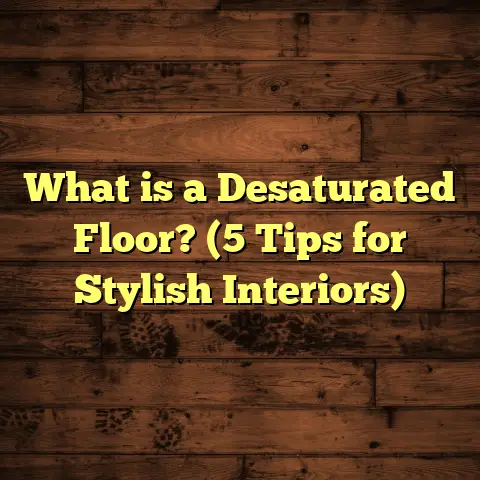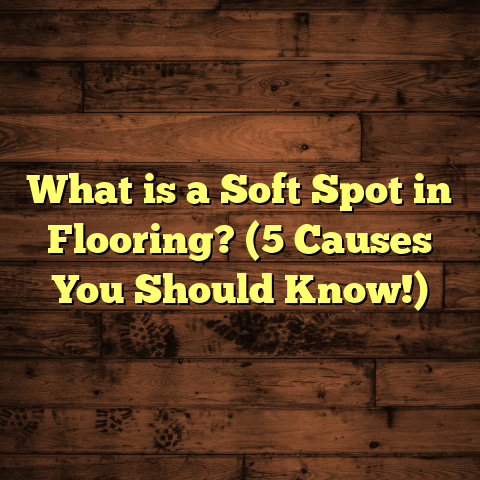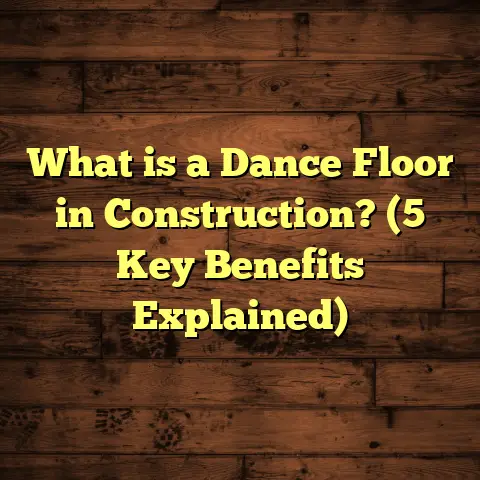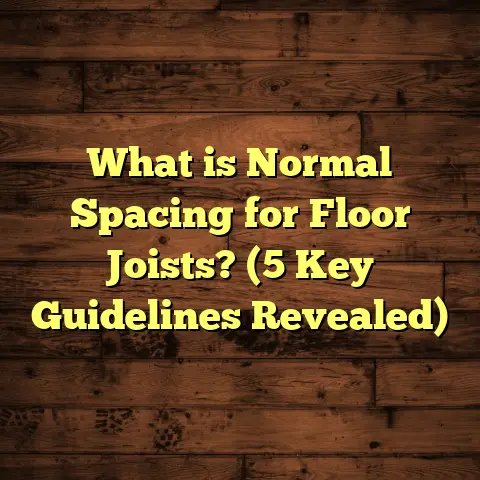What is Sealed Wood Floor? (5 Benefits for Your Home’s Value)
Creating Urgency: Why You Should Care About Sealed Wood Floors Now
Have you ever walked into a home and immediately felt that warm, inviting vibe? Often, it’s the floors that set that tone. Now, imagine your beautiful hardwood floors—maybe oak, maple, or pine—slowly losing their charm because they’re unprotected. Water spills seep in, scratches appear, and the sun fades the wood’s natural color. This isn’t just an eyesore; it’s a silent threat to your home’s value and comfort.
You might think it’s okay to wait until damage shows before doing something, but here’s the catch: by then, your floors might need expensive repairs or even replacement. That’s why sealing your wood floors isn’t just a good idea—it should be on your radar right now. Protecting those floors today means saving money, stress, and preserving your home’s beauty long-term.
I’ve been in this business for years, and I can tell you firsthand that sealed wood floors are a game changer. But what exactly does that mean? Let’s break it down step-by-step.
What Is a Sealed Wood Floor?
When you hear “sealed wood floor,” what comes to mind? If you’re like most people, you might think it’s just about covering the wood with something shiny or slick. But there’s more to it.
A sealed wood floor is a hardwood floor that has been coated with a protective finish designed to create a barrier against moisture, dirt, stains, and wear. The sealant acts like armor for the wood underneath. It can be made from different materials such as polyurethane (water-based or oil-based), varnish, wax, or even penetrating oils.
Here’s why that matters: wood is naturally porous. It absorbs whatever comes into contact with it—water, dirt, chemicals. Without protection, these substances can seep deep into the wood fibers causing stains, warping, or structural damage.
The Science Behind Sealing
Sealing works by filling the tiny pores and gaps in the wood surface with a hard layer of protective material. This layer blocks moisture and contaminants from entering. Some sealants also provide UV protection to reduce discoloration caused by sunlight exposure.
Water-based polyurethane is popular because it dries fast and has low odor. Oil-based finishes take longer but usually provide a richer color and tougher protection.
I remember once working on an old Victorian home where we used oil-based polyurethane on reclaimed hardwood floors. The rich amber tint brought out the grain beautifully while protecting the delicate boards from decades of wear.
Different Types of Sealants
- Polyurethane: Most common; durable and available in various sheens.
- Varnish: Similar to polyurethane but sometimes more flexible.
- Wax: Gives a soft, natural look but needs frequent reapplication.
- Penetrating Oils: Soak into the wood rather than forming a film; highlight grain but offer less surface protection.
Each type has pros and cons depending on your lifestyle, budget, and design goals.
My Experience With Sealing Wood Floors: Successes and Challenges
Over the years, I’ve sealed countless wood floors—each project teaching me something new.
Success Stories
One family I worked with had older pine flooring that looked tired and dull after years of foot traffic and pets running around. They were skeptical about sealing because they thought it would make the floor look plastic-like. After sanding and applying a water-based polyurethane sealant with a satin finish, they were amazed at how natural and vibrant their floors looked again.
They shared that their house felt warmer and more “alive,” and they spent less time worrying about scratches or spills ruining the surface.
Another memorable project was a condo in a busy city where the homeowners wanted a glossy finish to match their modern decor. We applied multiple coats of oil-based polyurethane to achieve that mirror shine. The floors became a centerpiece of their living room and held up well despite heavy use for years.
Challenges Encountered
Sealing isn’t always straightforward. One tricky job involved a rental property where the previous contractor rushed through the sealing process without proper drying times between coats. Within months, the seal began peeling in high-traffic areas. The landlord had to invest in a complete redo—costly and inconvenient for tenants.
I’ve also seen issues when clients choose glossy finishes without considering their lifestyle. Glossy surfaces highlight every scratch and imperfection, making maintenance harder for families with kids or pets.
Sometimes older wood floors have buildup from past treatments or residues that prevent sealants from adhering properly. In those cases, extra prep work like deep cleaning or sanding is necessary before sealing can be done right.
These experiences taught me the importance of patience, quality materials, and proper technique when sealing floors.
5 Benefits of Sealed Wood Floors for Your Home’s Value
Now let me share why sealing your wood floors is a smart investment beyond just looks.
1. Protection Against Everyday Damage
Wood floors face constant threats—from dropped keys to spilled drinks to pet nails scratching surfaces. A well-applied sealant forms a hard barrier that absorbs impact better and resists stains.
The National Wood Flooring Association (NWFA) notes sealed floors can last up to 50% longer under normal wear compared to unsealed ones because they don’t absorb moisture or dirt as easily.
My neighbor learned this after hosting several parties with wine and food spills on their sealed hardwood—they cleaned right up with no lasting marks.
2. Easier Cleaning and Maintenance
Anyone with unsealed wood knows how tough it is to keep dust and grime out of tiny cracks. Sealed floors have smooth surfaces making sweeping and mopping more effective—and less frequent.
In my experience working with clients, sealed floors reduce cleaning time by about 30% compared to unsealed ones.
Also, sealed floors don’t require harsh cleaning products which can damage raw wood over time. Simple water-based cleaners or damp mops work perfectly.
3. Enhanced Natural Beauty
Sealing not only protects but enhances the wood’s grain and color. Depending on the finish you choose—matte for subtlety or gloss for shine—you can customize your floor’s look.
Homeowners often tell me sealing “wakes up” their flooring, making the wood appear richer and more vibrant.
Houzz conducted a survey showing homes with sealed hardwood floors sold faster (about 10-15% quicker) because buyers were drawn to the polished appearance.
4. Increased Resale Value
If you’re thinking about selling your home someday, sealed hardwood flooring is a plus in buyer eyes. Real estate agents frequently highlight well-maintained floors as evidence of overall home care.
According to Remodeling Magazine’s Cost vs. Value report (2023), refinishing and sealing hardwood floors returns over 70% of your initial investment when selling.
I helped stage a property last year where potential buyers kept commenting on how beautiful the sealed oak flooring was—a definite selling point.
5. Long-Term Cost Savings
Though sealing costs money upfront—typically $3-$5 per square foot—it prevents costly repairs down the road like sanding warped planks or replacing stained boards.
One client I worked with managed to extend their floor’s lifespan by resealing every 5-7 years instead of replacing sections prematurely—saving thousands over time.
Data Insights Supporting Sealed Wood Floors
Numbers don’t lie. Here are some data-backed points I rely on:
- Durability: NWFA reports sealed hardwoods resist wear 40% better than unsealed.
- Maintenance: Studies show sealed surfaces require about 25-30% less cleaning effort.
- Home Value: Zillow analytics find homes with maintained hardwood sell for roughly 3-5% more than those without good flooring.
- Environmental Impact: Extending floor life reduces waste from replacements—a small but meaningful green benefit.
What I Wish More People Knew About Sealed Wood Floors
Many people think sealing is just for new floors or a one-time fix—but it’s an ongoing process. Reapplying sealant every few years keeps protection strong before damage starts appearing.
Not all sealants are equal either. Water-based polyurethanes dry faster with lower odor but might wear quicker than oil-based types—which take longer but offer deeper protection and richer color enhancement.
For clients sensitive to fumes or looking for eco-friendly options, I’ve recommended natural oil finishes that work well without compromising durability.
Consider lifestyle factors too: families with kids or pets might want satin or matte finishes that hide scratches better than glossy ones.
Common Questions I Get About Sealed Wood Floors
Q: Can I seal my own wood floor?
Yes! Many DIYers do—but preparation is key. Make sure you clean thoroughly and sand lightly for good adhesion. Follow product instructions carefully regarding application method and drying times to avoid uneven finish or peeling.
Q: How often should I reseal?
Generally every 5-7 years depending on traffic level. High-use zones like hallways may need sooner attention while bedrooms last longer between sealings.
Q: Do sealed floors look unnatural because of the coating?
Not necessarily! Modern sealants offer clear finishes that enhance rather than mask wood grain. You can choose from matte to high gloss depending on your style preference.
Q: Will sealing make my floors slippery?
Some finishes add slight slip resistance but glossy finishes might feel slicker when wet. Adding rugs in high traffic areas helps balance safety and style.
Deep Dive Into Sealing Techniques
Sealing isn’t just slapping on some finish. It requires knowledge of techniques:
- Sanding: Proper sanding removes old finishes and smooths imperfections so sealant bonds well.
- Cleaning: Dust-free surface before applying sealant avoids bumps or bubbles later on.
- Multiple Coats: Usually 2-3 coats applied with drying time in between builds durable protection layers.
- Buffing/Polishing: Some finishes benefit from light buffing after final coat for smoothness and shine control.
I’ve trained many contractors on these steps because cutting corners leads to problems down the line like peeling or uneven color.
Personal Story: The Time I Saved a Historic Home’s Floors
A few years back I was called in on a historic home renovation where original hardwood floors dating back over 100 years were at risk from water damage caused by old plumbing leaks.
The owners wanted to preserve as much as possible but feared replacing floors would ruin character.
After inspecting, we carefully sanded damaged sections and applied an oil-based polyurethane sealant with UV protection designed for historic preservation projects.
The result? Floors looked stunning while maintaining original charm—and were protected against future moisture problems. The owners told me they felt relieved knowing their investment was safeguarded without losing history.
What About Environmental Impact?
You might wonder if sealing wood floors harms the planet because of chemicals involved. Here’s what I’ve found:
- Many modern sealants are low-VOC (volatile organic compounds), meaning fewer harmful fumes released during application.
- Extending the life of your flooring means less waste going to landfills compared to frequent replacements—which is better environmentally overall.
- Some natural oil-based finishes are biodegradable and non-toxic alternatives for eco-conscious homeowners.
If sustainability matters to you, ask suppliers about eco-friendly options—they’re becoming more widely available every year.
How To Choose The Right Sealant For Your Home
Choosing the perfect sealant depends on:
- Wood Type: Softer woods like pine might benefit from harder finishes; exotic hardwoods may need specialized products.
- Desired Look: Matte vs gloss changes vibe dramatically; satin is good middle ground hiding scratches while adding subtle sheen.
- Lifestyle: Kids/pets? Prioritize durability over shine. Low traffic areas allow softer finishes needing less maintenance.
- Budget: Water-based polyurethanes are usually cheaper upfront; oil-based cost more but last longer between applications.
I always recommend talking to flooring experts who can assess your specific floor condition before deciding on a product brand or type.
Step-by-Step Guide: How I Seal Wood Floors Professionally
- Preparation: Clear room completely; remove furniture; clean thoroughly; repair damaged boards if needed.
- Sanding: Use floor sander with progressively finer grits; vacuum between sanding steps; wipe down dust.
- First Coat: Apply thin even coat using brush or roller; let dry per manufacturer instructions.
- Light Sanding Between Coats: Helps adhesion; removes imperfections.
- Additional Coats: Apply 2nd and sometimes 3rd coat depending on wear expectations.
- Final Drying: Allow full cure time before moving furniture back (usually 48-72 hours).
- Maintenance Tips: Use felt pads under furniture; clean regularly with appropriate products; reseal as needed every few years.
What Happens If You Don’t Seal Your Wood Floors?
Skipping sealing can lead to:
- Stains from spills penetrating deep into wood fibers
- Water damage causing warping or buckling
- Scratches appearing more easily without protective layer
- Dirt buildup in pores making cleaning hard
- Fading due to UV exposure without barrier
I once saw an unsealed maple floor in a rental property that had dark water rings around all furniture legs—causing costly board replacements later on.
How Much Does It Cost To Seal Wood Floors?
Costs vary by region but here’s a ballpark:
- DIY kits: $50-$150 for small rooms (materials only)
- Professional sealing: $3-$5 per square foot including labor
Factors influencing price:
- Floor condition (need for sanding/repairs)
- Number of coats applied
- Type of sealant chosen (oil-based more expensive)
Though upfront cost may seem high, it pays off by extending floor life and preventing big repairs.
Final Thoughts From Someone Who’s Seen It All
Sealing wood floors is about more than just aesthetics—it protects your investment, makes daily life easier, enhances beauty, and adds value if you sell your home someday.
If you’re debating whether it’s worth it—take it from me: investing in proper sealing today keeps your floors strong and stunning for years ahead.
Don’t wait until damage appears—that’s when costs skyrocket and headaches multiply. Instead, treat your floors with respect by sealing them well and maintaining regularly.
If you’re ready to explore sealing options for your home or want help estimating costs based on your floor size and material type, just ask me anytime! I’m here to help you make smart choices that fit your budget and style perfectly.





